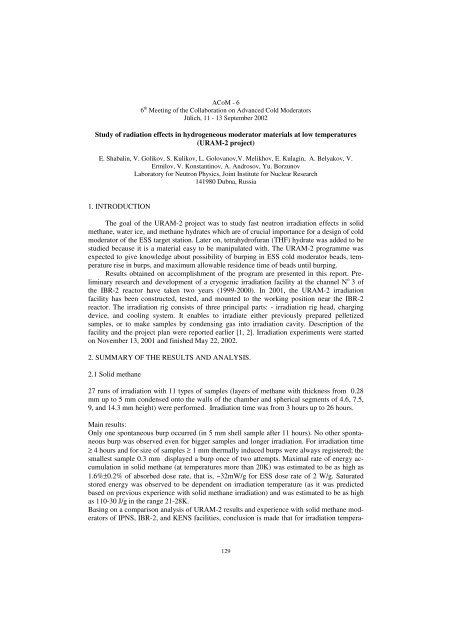Druck-Materie 20b.qxd - JUWEL - Forschungszentrum Jülich
Druck-Materie 20b.qxd - JUWEL - Forschungszentrum Jülich
Druck-Materie 20b.qxd - JUWEL - Forschungszentrum Jülich
Create successful ePaper yourself
Turn your PDF publications into a flip-book with our unique Google optimized e-Paper software.
ACoM - 6<br />
6 th Meeting of the Collaboration on Advanced Cold Moderators<br />
<strong>Jülich</strong>, 11 - 13 September 2002<br />
Study of radiation effects in hydrogeneous moderator materials at low temperatures<br />
(URAM-2 project)<br />
E. Shabalin, V. Golikov, S. Kulikov, L. Golovanov,V. Melikhov, E. Kulagin, A. Belyakov, V.<br />
Ermilov, V. Konstantinov, A. Androsov, Yu. Borzunov<br />
Laboratory for Neutron Physics, Joint Institute for Nuclear Research<br />
141980 Dubna, Russia<br />
1. INTRODUCTION<br />
The goal of the URAM-2 project was to study fast neutron irradiation effects in solid<br />
methane, water ice, and methane hydrates which are of crucial importance for a design of cold<br />
moderator of the ESS target station. Later on, tetrahydrofuran (THF) hydrate was added to be<br />
studied because it is a material easy to be manipulated with. The URAM-2 programme was<br />
expected to give knowledge about possibility of burping in ESS cold moderator beads, temperature<br />
rise in burps, and maximum allowable residence time of beads until burping.<br />
Results obtained on accomplishment of the program are presented in this report. Preliminary<br />
research and development of a cryogenic irradiation facility at the channel N o 3 of<br />
the IBR-2 reactor have taken two years (1999-2000). In 2001, the URAM-2 irradiation<br />
facility has been constructed, tested, and mounted to the working position near the IBR-2<br />
reactor. The irradiation rig consists of three principal parts: - irradiation rig head, charging<br />
device, and cooling system. It enables to irradiate either previously prepared pelletized<br />
samples, or to make samples by condensing gas into irradiation cavity. Description of the<br />
facility and the project plan were reported earlier [1, 2]. Irradiation experiments were started<br />
on November 13, 2001 and finished May 22, 2002.<br />
2. SUMMARY OF THE RESULTS AND ANALYSIS.<br />
2.1 Solid methane<br />
27 runs of irradiation with 11 types of samples (layers of methane with thickness from 0.28<br />
mm up to 5 mm condensed onto the walls of the chamber and spherical segments of 4.6, 7.5,<br />
9, and 14.3 mm height) were performed. Irradiation time was from 3 hours up to 26 hours.<br />
Main results:<br />
Only one spontaneous burp occurred (in 5 mm shell sample after 11 hours). No other spontaneous<br />
burp was observed even for bigger samples and longer irradiation. For irradiation time<br />
≥ 4 hours and for size of samples ≥ 1 mm thermally induced burps were always registered; the<br />
smallest sample 0.3 mm displayed a burp once of two attempts. Maximal rate of energy accumulation<br />
in solid methane (at temperatures more than 20K) was estimated to be as high as<br />
1.6%±0.2% of absorbed dose rate, that is, ~32mW/g for ESS dose rate of 2 W/g. Saturated<br />
stored energy was observed to be dependent on irradiation temperature (as it was predicted<br />
based on previous experience with solid methane irradiation) and was estimated to be as high<br />
as 110-30 J/g in the range 21-28K.<br />
Basing on a comparison analysis of URAM-2 results and experience with solid methane moderators<br />
of IPNS, IBR-2, and KENS facilities, conclusion is made that for irradiation tempera-<br />
129

















